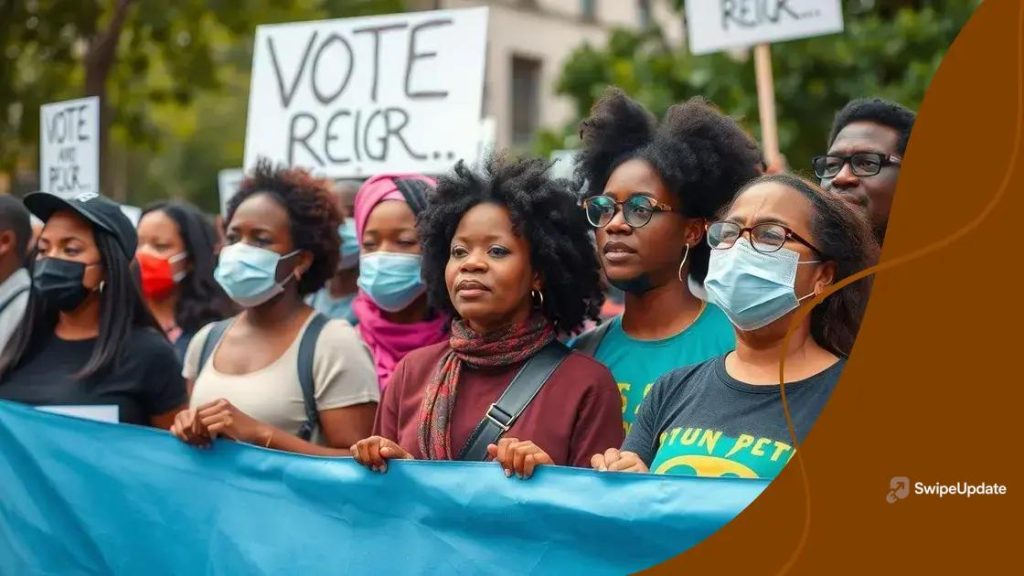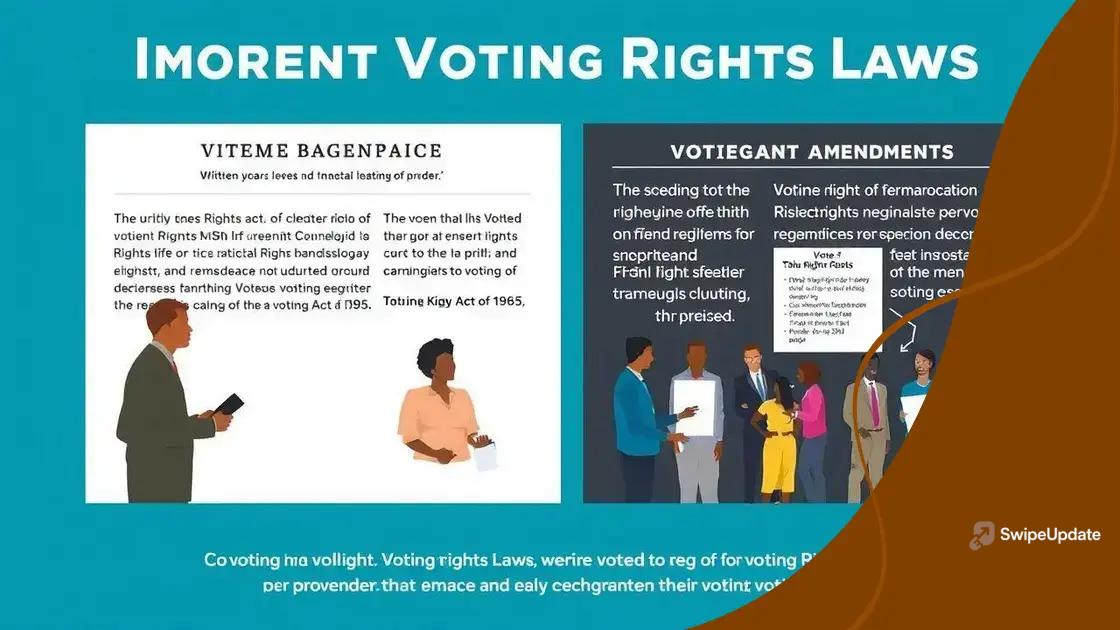Efforts to protect voting rights for all citizens

Efforts to protect voting rights in America are focused on combating barriers such as voter ID laws and ensuring fair access through grassroots movements and key legislation like the Voting Rights Act of 1965.
Efforts to protect voting rights are crucial in ensuring that every citizen can participate in democracy. Have you ever wondered how historical struggles shape today’s laws? Let’s dive into this important issue.
Understanding the history of voting rights
Understanding the history of voting rights is essential for appreciating the struggles and triumphs of those who fought for fair representation. Over time, various movements have paved the way for the rights we often take for granted today.
In the early years of American history, voting was primarily limited to white male landowners. This exclusivity sparked numerous movements aimed at expanding voting rights to all citizens.
The Suffrage Movement
One of the most significant milestones in voting history is the Women’s Suffrage Movement, which emerged in the late 19th century. Women organized, protested, and fought for their right to vote, culminating in the 19th Amendment in 1920.
Key Events Shaping Voting Rights
- The 15th Amendment prohibited denying the right to vote based on race, granting African American men voting rights.
- The Voting Rights Act of 1965 aimed to overcome legal barriers at the state and local levels that prevented African Americans from exercising their right to vote.
- Various Supreme Court rulings have shaped the interpretation of voting rights, influencing legislation and voter access.
Throughout the 20th century, activists continuously challenged injustices and worked to ensure every citizen’s right to vote. Innovations like early voting and mail-in ballots resulted from these ongoing efforts to make voting more accessible.
Today, as we reflect on the history of voting rights, it’s vital to recognize that this struggle is ongoing. Every election reminds us of the importance of participating and safeguarding these hard-won rights.
Current challenges to voting access
Current challenges to voting access are significant barriers that many citizens face today. As laws and regulations evolve, understanding these challenges is crucial for ensuring that every voice is heard.
One major issue is voter ID laws, which require individuals to present specific forms of identification before voting. While supporters argue that this prevents fraud, critics believe it unnecessarily restricts access, especially for marginalized communities.
Barriers Faced by Voters
In addition to ID requirements, various other obstacles hinder voting access:
- Reduced polling places can lead to long lines and wait times.
- Lack of mail-in voting options can disenfranchise those unable to vote in person.
- Voter roll purges sometimes remove eligible voters from lists unfairly.
- Language barriers can prevent non-English speakers from understanding voting materials.
These barriers are compounded by systemic issues, such as socioeconomic factors that impact an individual’s ability to vote. Many low-income citizens struggle to take time off work or arrange childcare, making it difficult to access polling locations.
Moreover, legislation varies significantly from state to state, leading to confusion about voting procedures. Some states have implemented measures to make voting easier, while others have enacted stricter access laws, creating a patchwork of voting experiences across the country.
As the landscape of voting access continues to change, advocates are working tirelessly to remove barriers and ensure equitable access for all citizens. These efforts include legal challenges, public awareness campaigns, and grassroots organizing aimed at mobilizing voters.
Key laws protecting voting rights

Key laws protecting voting rights have been established to ensure fair access to the electoral process. These laws reflect the ongoing struggle to maintain and expand voting access for all citizens.
One significant piece of legislation is the Voting Rights Act of 1965. This law aimed to eliminate barriers that prevented African Americans and other minorities from voting. It prohibits discriminatory practices, such as literacy tests, and requires jurisdictions with a history of discrimination to obtain federal approval before making changes to their voting laws.
Important Amendments
Several constitutional amendments also play a critical role in protecting voting rights:
- The 15th Amendment prohibits the denial of the right to vote based on race, ensuring that African American men could vote after the Civil War.
- The 19th Amendment grants women the right to vote, marking a significant victory for the women’s suffrage movement in 1920.
- The 26th Amendment lowers the voting age to 18, allowing younger citizens to participate in elections.
In addition to federal laws, some states have enacted their own protective measures. These might include automatic voter registration and same-day registration, which make it easier for individuals to vote without facing unnecessary hurdles.
Despite these legislative advancements, the struggle for voting rights continues. Efforts to undermine these protections can surface, making it essential to remain vigilant and advocate for equitable access for all voters. Activism and public awareness play crucial roles in defending and promoting these key laws.
Grassroots movements advocating for change
Grassroots movements advocating for change play a vital role in the ongoing struggle for voting rights. These movements are driven by ordinary citizens who unite to create a collective voice, pushing for reforms that enhance democratic participation.
Throughout history, grassroots efforts have significantly influenced public policy and societal attitudes toward voting. By mobilizing communities, these movements raise awareness and advocate for equity in the electoral process.
Examples of Impactful Movements
Several grassroots movements have emerged over the years, championing the cause of voting rights:
- The Civil Rights Movement, which sought to end racial segregation and secure voting rights for African Americans.
- Women’s marches and organizations that advocated for the suffrage of women, leading to the ratification of the 19th Amendment.
- Young activists who focus on lowering the voting age, as seen in campaigns for the 26th Amendment.
In addition to historical movements, contemporary organizations continue to fight for change. Groups like the American Civil Liberties Union (ACLU) and the League of Women Voters engage in grassroots advocacy to promote voting access and educate citizens on their rights.
These grassroots efforts often involve community events, rallies, and social media campaigns aimed at mobilizing voters. They emphasize the importance of understanding voting laws and engaging with local representatives to advocate for improved access to the polls.
As challenges to voting access persist, grassroots movements remain essential in creating dialogue, inspiring action, and reminding the public of the power of collective advocacy.
The future of voting rights in America
The future of voting rights in America is shaped by ongoing debates and actions aimed at ensuring equitable access for all citizens. As challenges continue to arise, understanding the trends and potential changes is vital.
Legislative efforts are at the forefront of this discussion. Recently, several states have proposed reforms aimed at loosening voting restrictions. These reforms could include easier registration processes and expanded access to mail-in ballots, making it more convenient for everyone to vote.
Emerging Trends
Several key trends are shaping the future of voting rights:
- Increased advocacy for automatic voter registration, which could help ensure that all eligible citizens are registered to vote.
- Efforts to address gerrymandering, which manipulates district boundaries to favor one party over another, impacting fair representation.
- Adoption of security measures for election integrity that maintain trust in the voting process without obstructing access.
Technological advances also play a significant role in the evolution of voting. From online registration to digital polling systems, technology can enhance the voting experience. However, it is essential to ensure that these systems are secure and accessible to everyone.
Additionally, the role of grassroots movements will likely continue to grow. Activists and community organizers are increasingly important in mobilizing voters and advocating for changes in policy that protect voting rights.
As the landscape of democracy evolves, public awareness and engagement will be critical. A well-informed citizenry can push for reforms and hold elected officials accountable, ensuring that everyone has a voice in the democratic process.
FAQ – Frequently Asked Questions About Voting Rights
What is the Voting Rights Act of 1965?
The Voting Rights Act of 1965 is a landmark piece of federal legislation that prohibits racial discrimination in voting, ensuring that all citizens have the right to participate in elections.
How do grassroots movements impact voting rights?
Grassroots movements mobilize communities to advocate for change, raise awareness of voting issues, and push for laws that protect and expand voting rights.
What are some current challenges to voting access?
Current challenges include voter ID laws, reduced polling places, and restrictive registration processes that can disenfranchise certain groups.
How can individuals get involved in advocating for voting rights?
Individuals can get involved by participating in local organizations, attending advocacy events, and educating others about their voting rights.
